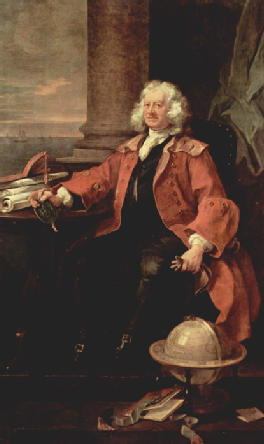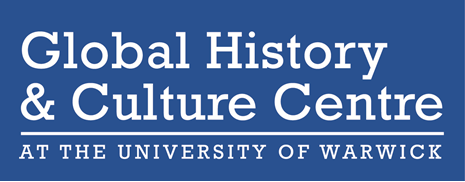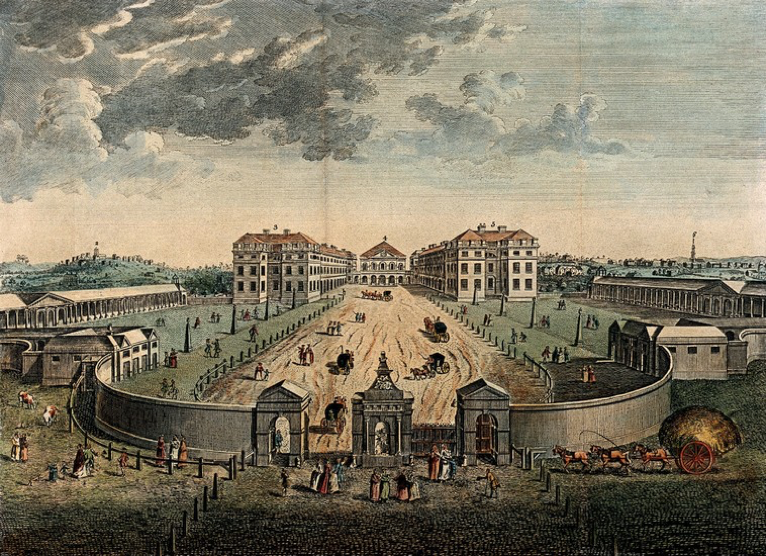Forgotten Children: Black Lives and the Eighteenth-Century Foundling Hospital
Published: 28 September 2020 - Hannah Dennett
Infant number 18,463, a male child aged two months, was admitted into the London Foundling Hospital on 6 October 1798. Like many of the women who sought the help of the institution, his mother, Mary Carne, was unmarried and unable to provide for her child. But if we dig a little deeper into the archives of the Foundling Hospital we find the story of Mary Carne and her baby boy throws a spotlight onto an untold part of the Foundling Hospital’s history – that of the presence and experiences of Black, Asian and mixed-race infants cared for by the charity during the long eighteenth-century.
 The ‘Hospital for the Maintenance of Exposed and Deserted Young Children’ was the vision of Thomas Coram. A shipwright who for many years had lived and worked in Massachusetts, he sought to provide an alternative for the newborn infants he saw abandoned in the streets of London. After years of campaigning, the Hospital opened its doors in Hatton Garden in 1741, before moving to purpose-built premises in Lamb’s Conduit Fields in 1745. Initially infants were fostered by wet nurses in the countryside, then on their return to London at around four years of age, the Hospital provided them with a basic education, religious instruction and some training in skills to prepare them for apprenticeships. Foundlings were later bound by indenture to a master or mistress once they reached their early teenage years.
The ‘Hospital for the Maintenance of Exposed and Deserted Young Children’ was the vision of Thomas Coram. A shipwright who for many years had lived and worked in Massachusetts, he sought to provide an alternative for the newborn infants he saw abandoned in the streets of London. After years of campaigning, the Hospital opened its doors in Hatton Garden in 1741, before moving to purpose-built premises in Lamb’s Conduit Fields in 1745. Initially infants were fostered by wet nurses in the countryside, then on their return to London at around four years of age, the Hospital provided them with a basic education, religious instruction and some training in skills to prepare them for apprenticeships. Foundlings were later bound by indenture to a master or mistress once they reached their early teenage years.
The PhD project I am currently working on at the University of Warwick in collaboration with the Foundling Museum was conceived by the Foundling Museum with the awareness that people of colour who encountered the Foundling Hospital during the eighteenth century are currently missing from the institution’s historical narrative. But who were these individuals and how do we uncover their stories?
Thomas Coram by William Hogarth (1740)
It appears that the colour of a child’s skin or the place of origin or ethnicity of parents were not systematically recorded in the Hospital’s paperwork during the eighteenth century. So I am grateful for the expertise of the Foundling Museum staff in helping me navigate the different sources which might offer possible clues, and for Janette Bright’s extensive research into the billet books, which has been an invaluable starting point.

The Foundling Hospital in the Eighteenth Century
When a child entered the Hospital they were assigned a unique identification number, which in the earlier years of the institution was recorded on a billet form, with the date of admittance and descriptions of any clothing worn by the child. At the bottom of the page under the heading ‘Marks on the Body’, occasionally terms such as ‘tawny’, ‘like a Moor’ and ‘mulatto’ were added, suggesting these were non-white children. Using their identification numbers from the billets, it has been possible to discover the names these children received when baptised on their admittance, and details about where they were sent to nurse and whether they died in infancy or survived to be apprenticed.
Another fruitful collection of sources is the petitions. In the latter half of the eighteenth century, on applying to the Hospital mothers were required to submit a petition to the General Committee providing some details of their circumstances. A few petitions mention the place of origin of the mother which offers an insight into the possible ethnicity of the mother and therefore her child. Once a petition was submitted to the Committee, enquiries were made into the truth of the mother’s circumstances and the outcomes reported back. These reports often add details about the father of the child and the mother’s previous employment.
The case of Mary Carne and her male infant demonstrates how these sources yield relevant information. Mary’s petition states that whilst attending as a half-boarder at a school in Mitcham where she was learning the skills of a domestic servant, she, ‘in an unguarded moment was connected with a Negro boy of fifteen years of age, servant of her governess’. It explains her need to have her son accepted into the Foundling Hospital because of her young age, being only eighteen, and because ‘of the incapacity of the father of the child, who is slave of her late governess’s husband’.[1]
Other records show her son to be foundling number 18,453, who was christened Thomas Trowbridge on his entry into the Hospital. He was sent to nurse with Jane Richards in East Peckham, Kent, under the supervision of the inspector Mr Vine. Unfortunately, Thomas died only a few months later, in June 1799. On informing the Governors of Thomas’ death, Mr Vine wrote that ‘he has had every thing done for him that the Doctor or myself could think of and under the care of an exceeding good nurse’.[2]
Thomas Trowbridge is one example of the infants whose records suggest that Black, Asian and mixed-race children were subject to the same admittance processes, care and educational opportunities as their white peers. This implies it was their status as infants of poor, unmarried mothers which was the primary consideration when their cases were being evaluated by the Committee. Similarly, the opportunity to rescue and mould their lives, just like the other children in the Hospital, informed their subsequent experiences.
Not only do they confirm the presence of children of colour in the Hospital, the sources also provide a window into the lives of their mothers; the employment many of them were engaged in, the areas of London or the wider country in which they lived or worked, or their reasons for travelling to London from the colonies. They highlight many interracial encounters, with some pregnancies the result of rape and others from relationships when the fathers then deserted the mothers. Whilst often mediated through a third person writing on their behalf, the snippets of women’s lives that the petitions reveal add to our ability to access the experiences of women from the lower orders of society, and especially women of colour in this period.
Although this project is still in its infancy, the research has already revealed more incidences of children of colour being admitted into the Foundling Hospital in the eighteenth century than we anticipated it would be possible to discover. They represent only a tiny fraction of the thousands of infants who passed through the institution during this period, but the lives of these foundlings, no longer forgotten, are important for shaping a more complete history of the Foundling Hospital.
Hannah Dennett is a PhD researcher at the Department of History, University of Warwick. Her project Forgotten Foundlings: Black Lives and the Eighteenth-Century Foundling Hospital is a collaborative PhD with the London Foundling Museum and is funded by Midlands4Cities.
To learn more about the history of the Foundling Hospital and the work of the Foundling Museum: https://foundlingmuseum.org.uk
To discover the story of Black Peggy, a mother from Bengal who petitioned the Foundling Hospital in 1793: https://scroll.in/article/970361/my-search-for-black-peggy-a-bengal-native-who-was-seduced-with-false-promise-of-marriage



